'I call my OCD Olivia'
- Published
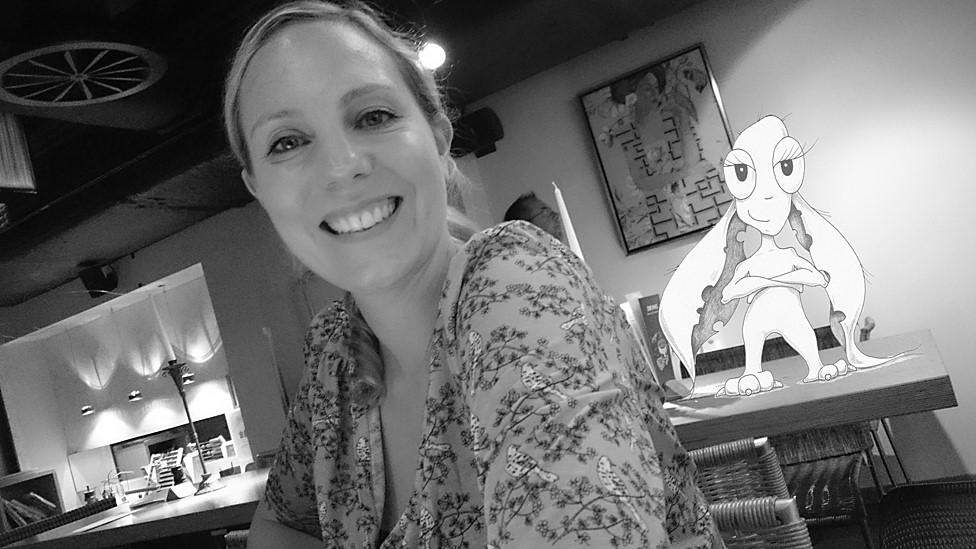
Catherine Benfield wasn't diagnosed with OCD until she was 31, after she had her first child, though it would appear she's had it all her life. She recovered with the help of therapy - and by creating a character who personifies her obsessive-compulsive behaviour.
"She's got the big ears, because she's like a startled hare, she's listening out.
"She's bedraggled, because she's been through a lot and she's normally having some kind of panic.
"The big eyes are about making sure she's keeping an eye out for danger.
"The big legs - for running," like a frightened hare, says Catherine Benfield.
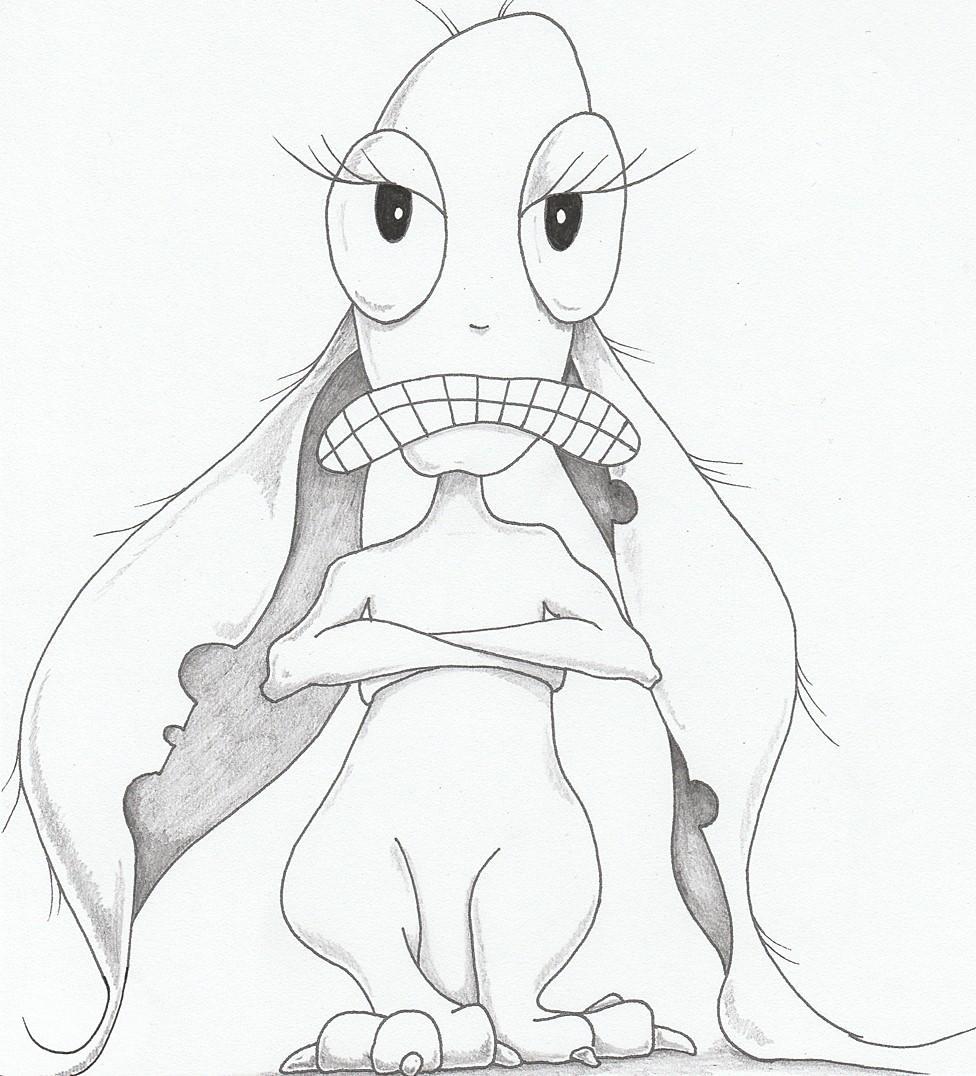

And she can change too - very quickly. She can be quiet one moment, but then her mood will swing and she'll suddenly be feeling at the end of her tether, forlorn, broken and, at her worst, absolutely beaten.
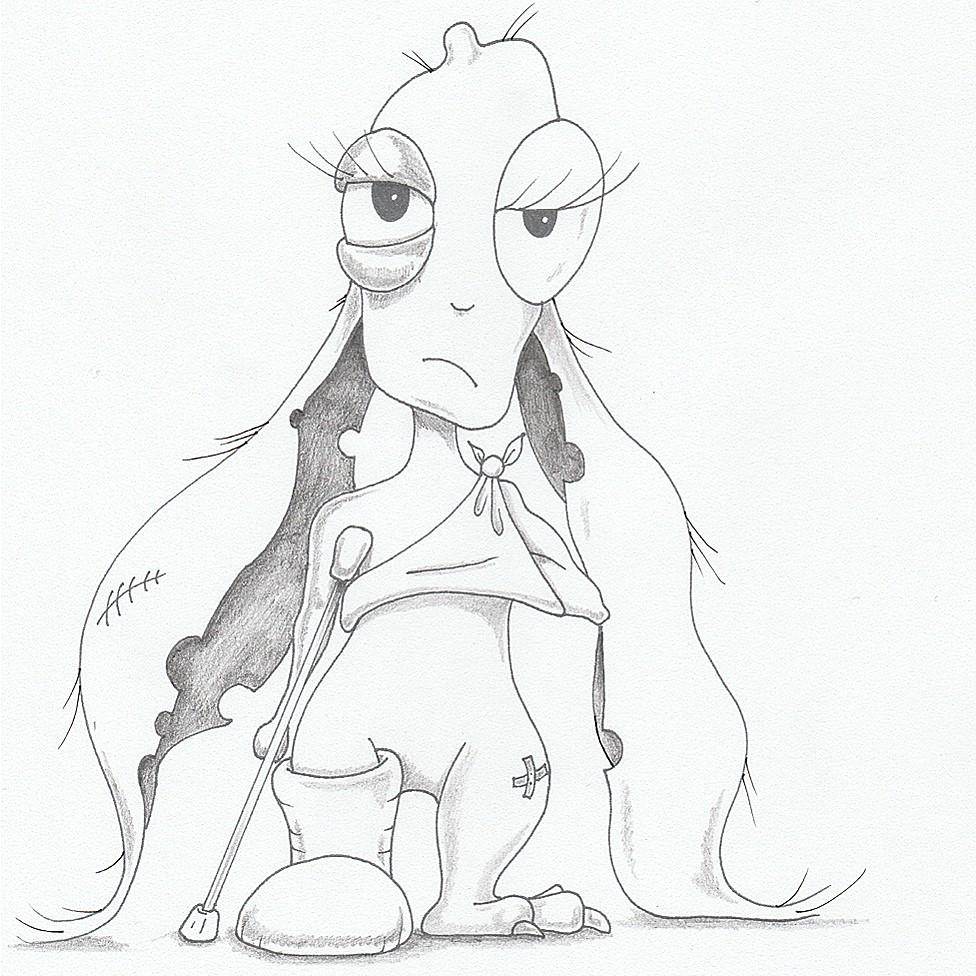

You have now met Olivia.
She is a visualisation - a character created by Catherine to personify the condition she has lived with since she was a child.
The O in Olivia stands for OCD, an abbreviation for obsessive-compulsive disorder.
People are often mistaken about OCD, Catherine says. So many people think it's about being very fastidious and organising your pens very precisely on your desk but it's actually a serious anxiety-related mental health condition, involving intrusive obsessive thoughts, images and fears.
In an effort to prevent one of her fears coming true, Catherine would feel compelled to carry out a repetitive physical or mental act - in technical terms the fear is the "obsession" and the repetitive act is the "compulsion". This would provide temporary relief from the anxiety, but then it might return, compelling her to repeat the behaviour again and again.
Catherine says OCD often preys on kind and caring people.
"They're compassionate, they're sensitive to the needs of others," she says. "They love the people around them to an intensity where they will do anything to stop harm coming to them."
Between the ages of four and five, Catherine would stand staring out of the window for long periods, waiting for family members to return home and fearing that they had come to harm.
"I thought somehow the silent vigil would help bring them home safely," she says.
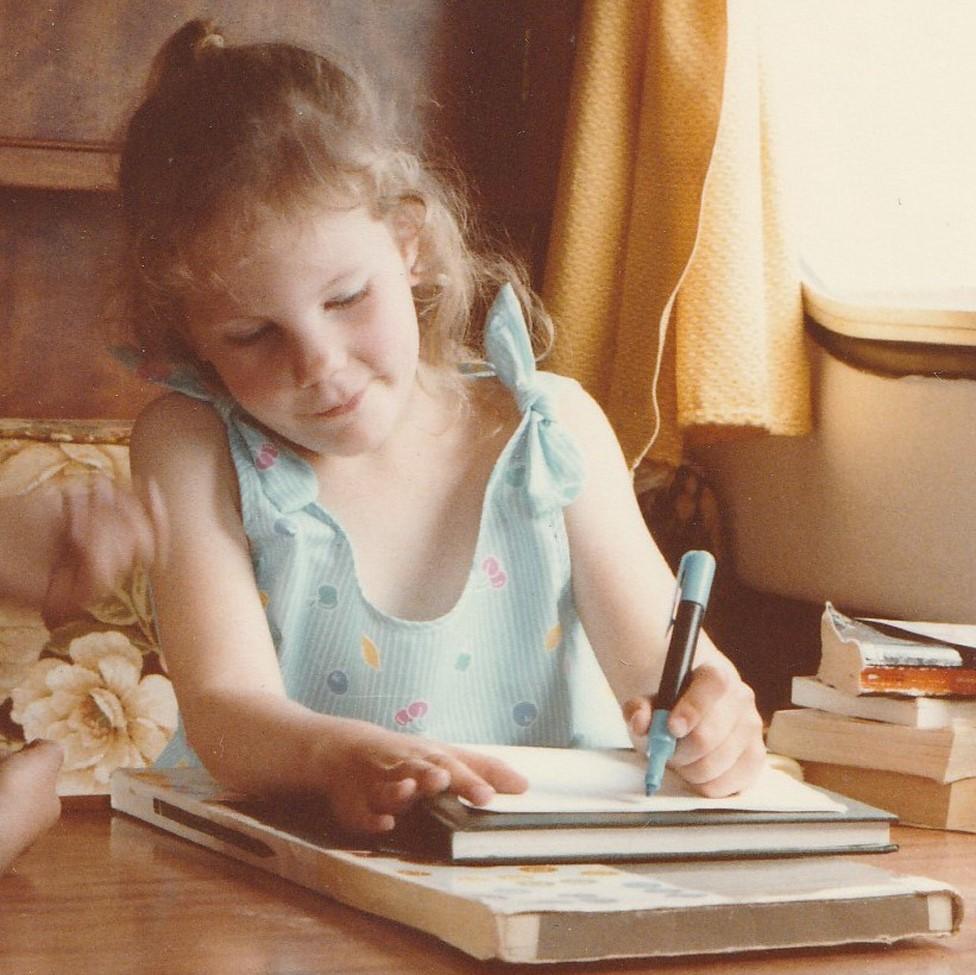
Catherine aged six

As a teenager she was terrified to be the last one to leave the house, because of the fear that it would burn down once she had gone - she would compulsively check the cooker was switched off and switches unplugged. And to ensure everyone was safe she would compulsively lock all doors and windows, and remove all trip hazards.
These routines could take hours to perform, and if one thing disturbed the process she would start all over again.
As time went on she became so busy with her studies and her job as a teacher that OCD had less of an impact on her life. It wasn't until she had her baby son at the age of 31 that she became really unwell.
"I had a horrible labour. I came away, I was very weak and I just couldn't do very much physically, it gave me a lot of time to think," she says.
"Almost immediately I started staying up all night to check he was breathing. Every parent has been known to check their child's breathing, particularly when it's newborn, but it grew to the point where I didn't feel like I could leave him at all. I wasn't sleeping, I wasn't eating."
At first she was terrified that something or someone would hurt him. Then she began to worry that she might harm him herself.
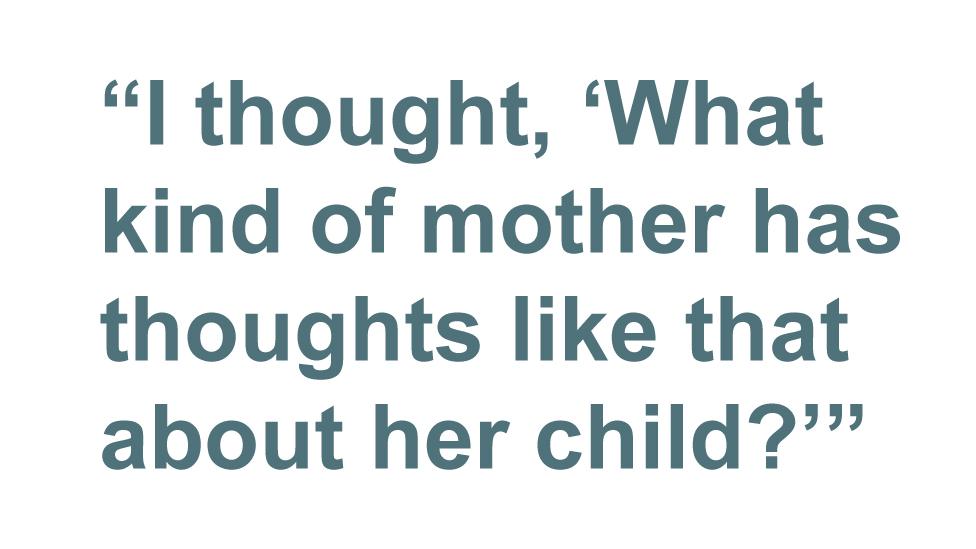
"I remember sitting on the sofa looking at my mother-in-law holding my kid in front of a wall and thinking how easy it would be to get up and throw him against it," she says.
"I could see it all, it was absolutely horrible and really detailed, very vivid, accompanied with images in my head of my future and what I'd have done to my family and my friends as a result."
She didn't know it, but what she was experiencing was perinatal OCD. Women with this condition would never actually carry out the actions they visualise, but Catherine's intrusive thoughts left her feeling anxious, depressed and isolated.
"I didn't know it was OCD," she says. "I thought I wanted to do it. I thought, 'What kind of mother has thoughts like that about their child?'"
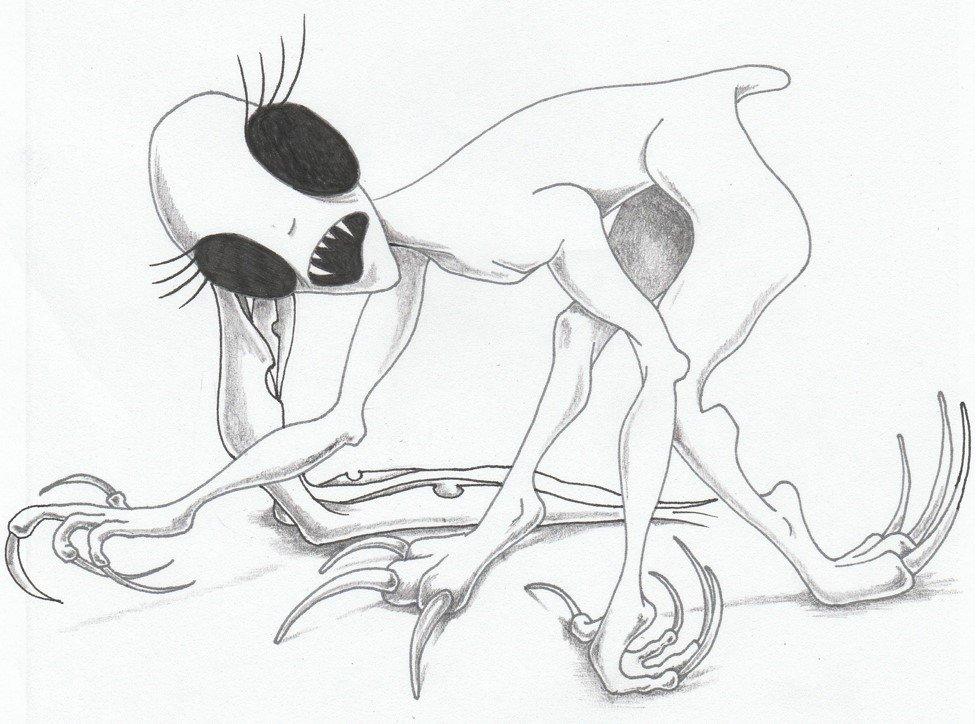

Consultant psychiatrist Dr Lynne Drummond says life events, both good and bad, are often a trigger for OCD.
"Childbirth is quite a major life event," she says. "Let alone the whole issue of suddenly having somebody who is completely and utterly dependent on you. Plus your [changing] hormones, plus you're knackered and you're probably at times down in the dumps and your body has had a huge change. You're physically at a lower ebb. Emotionally you have to come to grips with your change in role."
Catherine began to avoid anything that could hurt her son. She threw away all the knives in the house as she imagined herself hurting him with them. She was terrified to go on a station platform with the pram after having intrusive thoughts about pushing her son under a train.
She eventually became so anxious that she couldn't leave the house with her son.
"I was never suicidal, but I do remember at one point thinking, if the very worst comes to the very worst and I can't get through this, that is an option for me," she says.
"If you believe that you're a danger to your child, you'll do whatever you can to remove that danger and that was, I suppose, the ultimate thing that I could do."
She says no-one - including medical professionals - recognised her symptoms.
"I literally got to the point where my husband said, 'You need to come to the doctor's right now,' and so we went," says Catherine. "I walked in and I was literally like, 'I'm worried I'm going to harm my son,' and just burst into tears."
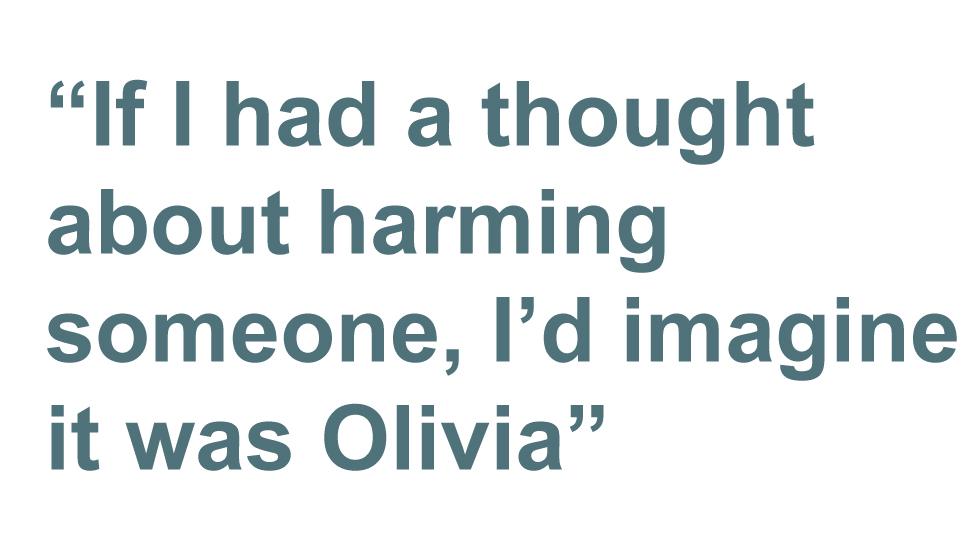
The GP told her it was anxiety and gave her medication. But when she tried to come off it her condition deteriorated again. One day, in desperation, she typed into Google "OCD and fear of harming son" and dozens of stories popped up.
"I hadn't thought that was going to happen," she says. "I thought I was a monster, and immediately everything that I had been thinking and feeling and going through was written down in front of me by all these other people."
Catherine had finally got a diagnosis - from the internet - after battling with OCD all her life. She then sought medical help, and about 18 months after she had her son Catherine started therapy.
This included cognitive behavioural therapy (CBT), a talking therapy which focuses on how your thoughts and attitudes affect your behaviour and feelings, and exposure and response prevention therapy (ERP), a form of CBT treatment where you are asked to confront your obsessions or fears and resist carrying out the compulsive behaviour.

Dr Lynne Drummond on "graded exposure" ERP therapy
What I'd do is get the patient to create a hierarchy of situations. I use a zero-to-eight scale with zero being no anxiety and eight complete panic. I'd get them to rate how anxious they would feel doing each thing without "putting things right" - in other words, performing the compulsion. I'd start with something that had an anxiety rating of three or four - mild-to-moderate anxiety - and encourage them to expose themselves to their fears for one to two hours without "putting things right". They would find that the anxiety would remain high and it would be absolutely horrible, but actually over that time it would go down - and each time they do it will be just that little bit easier.

This helped enormously, but Catherine found there was a big stumbling block on her road to recovery.
"Unless I could get a handle on the fact that actually I wasn't this monster, I wasn't going to be able to carry on getting better," she says. "And that's where Olivia came in."
Olivia was a way for Catherine to separate herself from her condition. Olivia personified her obsessions and her compulsive behaviour - but she could feel compassion for Olivia, and this enabled her to feel compassion for herself.
"If I had a really horrible thought about harming someone, I would imagine that it was Olivia hopping up and down and she was the one who was frightened, she was the one who was scared - and I'd feel for her.
"I'd be like, 'Come on don't be daft, this is just anxiety,' and by doing that I could then talk to myself in that way."
It was while she was washing up one day that the idea of Olivia came to her. She instantly visualised what Olivia looked like and decided to write a blog. Then she told her artist husband, Pete, who drew the otherworldly creature his wife described.
The impact was immediate. Catherine even went out and bought a set of knives for the house again.

Where to get help

"When I was getting the intrusive thought about the knives I could imagine Olivia bouncing up and down in a rage beside me and all I wanted to do was go, 'Look don't be silly, this is nothing, it's nothing.'"
Olivia Bamber from the charity OCD Action says therapy is the recommended treatment for OCD and that medication can also be helpful. But so can "separating OCD from yourself" - as Catherine has.
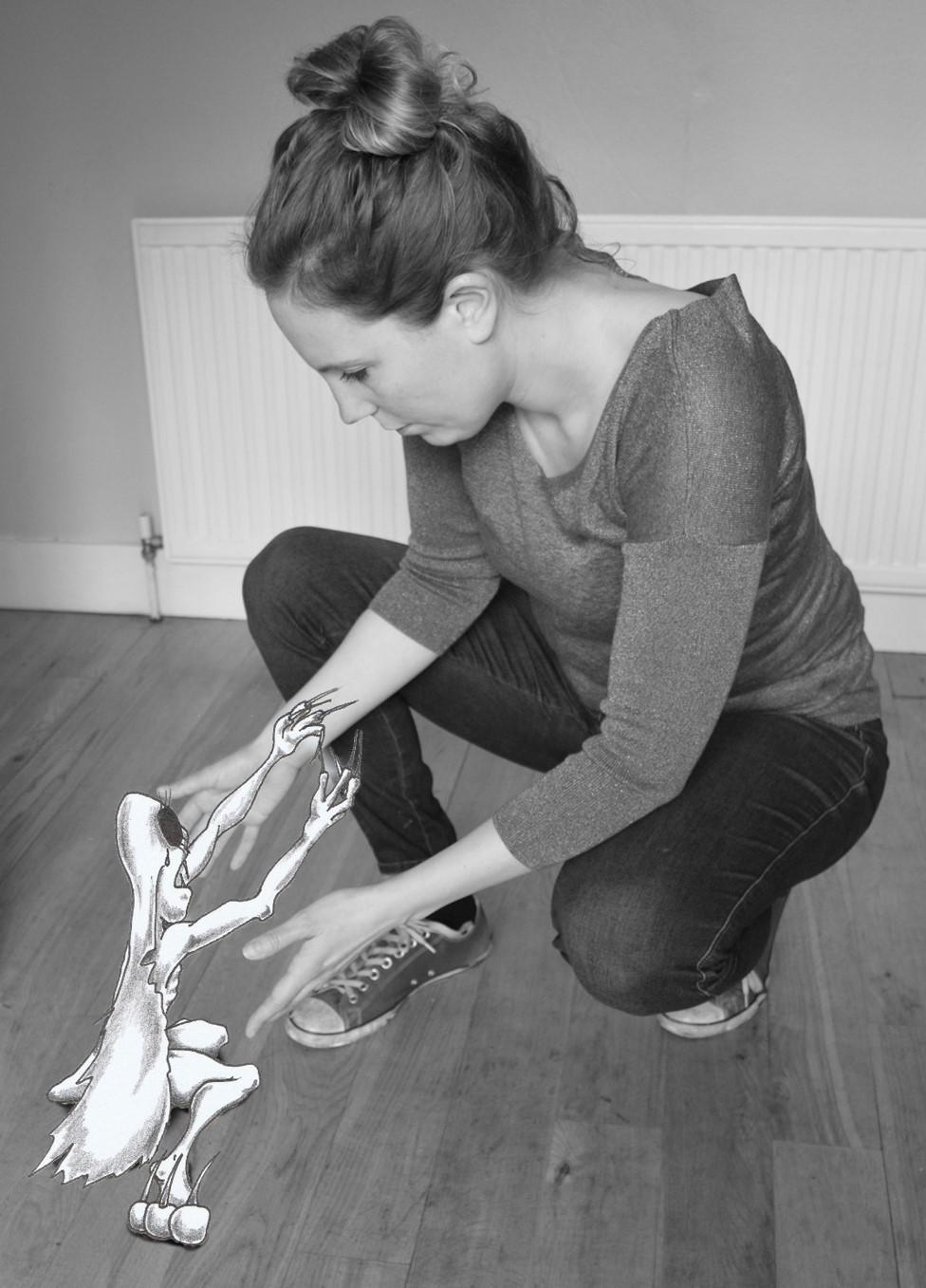

Catherine says she knows some people with OCD have called their condition "the bully", but she didn't want Olivia to be like this.
"I couldn't bear the thought of trying to imagine myself living with this evil face hovering over my shoulder. So I decided to have a character that I could show love and compassion," she says.
At the same time, Catherine worked hard on tasks set by her therapist.
She had become too terrified to go into a department store because of intrusive thoughts about throwing her son from the escalator. As part of her ERP therapy she was asked to start facing her worst fears and to travel up and down the escalators carrying her then two-year-old son in her arms.
"It was something that absolutely terrified me at first, but I went up and down those escalators so many times and on so many different occasions that I don't even think about it any more," she says.
She also had to stand on a station platform and deliberately bring on the thought of pushing her son under the train until it got to the point where she faced no anxiety at all.
"I don't see recovery as never having a symptom," she says. "I see recovery as being able to manage them or them not interfering massively in my day-to-day life."

Occasionally, Catherine says, OCD does try and nudge its way back into her life.
"As I was walking out of [my son's] bedroom last night, having said goodnight, there was a book on the floor and I thought if he gets up in the night and runs in to me he could trip on that and fall and hit his head, and so I moved it, that is what mums do, it makes sense," says Catherine.
"I got back into bed and I was like, 'Ah did I move it far enough out the way?' I knew I did, but I had to go back and I had to move it and then I was like, 'Stop it, stop it!' And that's where I employed all the stuff I learnt through using Olivia."
She didn't go back to check a second time, proving how far she has come.
But will Olivia ever disappear from her life?
"I still use that visualisation sometimes and I still use the things that I learnt from that every single day, even in areas of my life that are nothing to do with OCD," she says. "If I start having a negative thought about something - 'Did I do that right or wrong?' - I remember that self-compassion, and it started with her, so I don't think I will ever say goodbye to her."
Through her blog, Taming Olivia, Catherine now tries to help new mothers recognise the symptoms of OCD, external, and encourages them to show compassion towards themselves.
"It's our job to recognise our Olivias," she says, "but not to give into them."
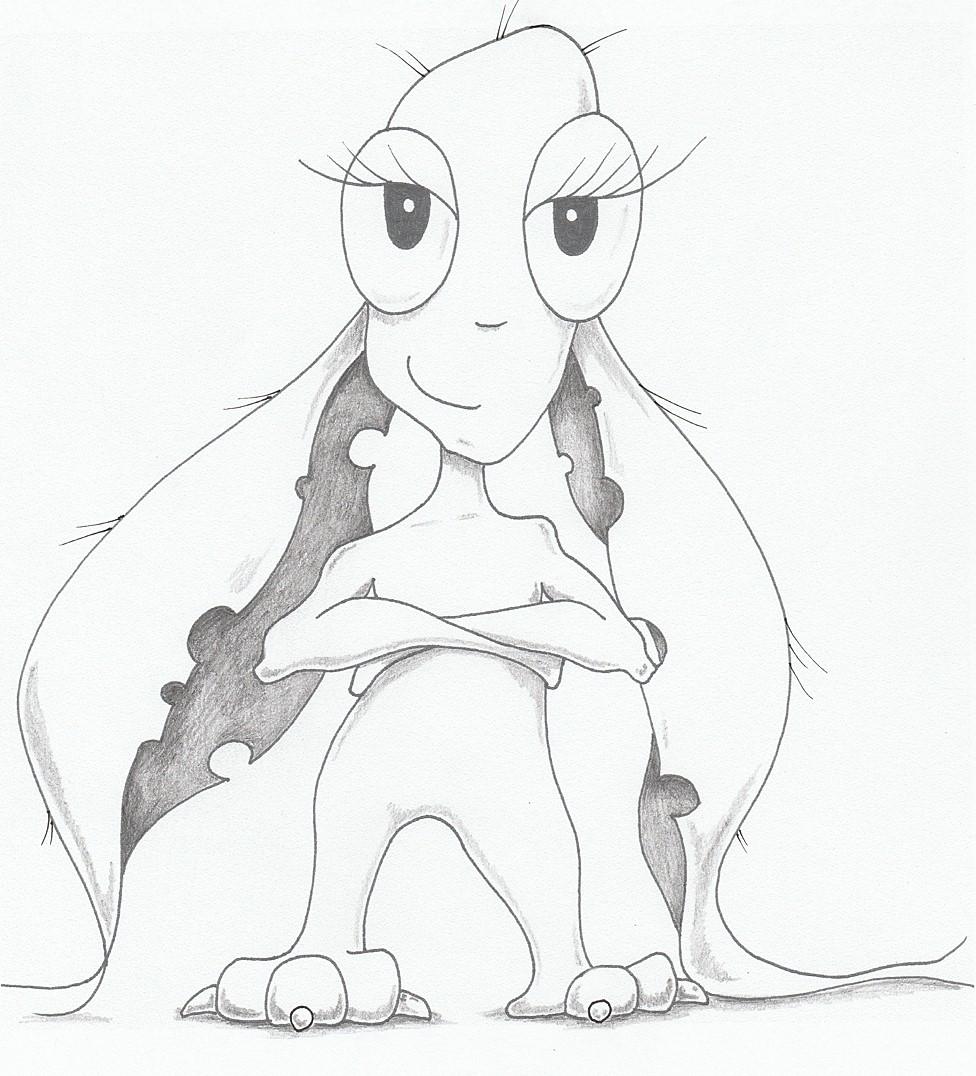

All illustrations of Olivia by Pete Benfield, external
Dr Lynne Drummond is the author of Obsessive Compulsive Disorder: All You Want to Know about OCD
Some of your comments:
Over a year ago I created a character called Alice because I experienced psychosis so whenever I felt/feel it creeping near I tut and say, "No Alice we're not going down the rabbit hole today." Earlier this year I read a book by Bryony Gordon called Mad Girl and learnt this creation of a character was quite healthy and a useful technique, a great thing to read as I felt this character creation may be perceived as mad despite it allowing me to grasp and control my mental illness. Katie, Bristol
My daughter who is eleven years old today was born three weeks early - leaving me with OCD symptoms. Id be in a panic most of the time because I thought I had "so much to do". I didn't see life as having a new born baby, I saw it as a minefield of things I must do and hardly felt any enjoyment. I lost all my confidence and thought everyone was judging me but I was in fact judging myself. I felt a complete failure and was very protective of her and worried for her every moment of the day. I refused to let a family member hold her for fear of her being dropped or harmed. Susan, Bridgwater
Although I have not had intrusive thoughts about my son I can fully understand this story I used to check windows doors cooker hundreds of times I'd get angry if I was interrupted and have to start again, everything had to be in multiples of 2, 4, 8, 16, 32, 64, 128, 256 and so on I could never count 60 seconds. My GP sent me to the Community Psychiatric Nurse and she advised CBT. I will never look back. I am a totally different happy person. My GP says it's the biggest transformation she's seen in anybody and I love it. I would recommend it to anyone. Melissa, Aldridge
I had exactly the same type of thoughts regarding harming my daughter when she was born. I removed all of the knives from the house and thought I must be a monster if I could think like that. I ended up having CBT and taking anti-depressants. Thankfully, I can deal with the thoughts now as I now know what they are and that I am not a horrible person. They are just thoughts. Unfortunately my daughter has inherited the same illness. She has regular issues with needing to be reassured everyone is OK. L Williams
I suffer from severe OCD too - intrusive thoughts about harming others and myself. I also created an avatar for my illness. A crow, who is unfortunately slightly more acidic than Olivia - my psychologist at the time advised against it but told me that if it made me feel better then at the end of the day, it was OK. I imagine a crimson knight who is the face of my self-harm and a gorgon who is the personification of my struggles with looking into mirrors - that I have now mostly overcome. My life was at a standstill for years, suffering intrusive thoughts from the age of nine. I wasn't diagnosed until I was in my twenties, and although I'm not on medication or seeing a professional these days, I feel that I have overcome the worst of my OCD by my own efforts explained in my blog, external. I can't explain how terrifying my thoughts have been. Yan, Norfolk
I'm pretty sure I have this too! I too was mistaken in thinking OCD was about repetitive obsessions such as hand washing or tidiness. I had no idea these thoughts and feelings are OCD - I too have just been thinking that there must be something wrong with me. I have three children and although I have had symptoms since I was a child, it is only been since their births that I have really struggled. It's horrific! I can picture clearly the face of one of my little girls as a car hits her, I can picture another daughter's shocked expression as a knife falls on to her and I can clearly see, like a photograph in my head, the faces of all three as they lay hurting somewhere from injuries I don't even know. And sometimes, as in the story here, it's me doing these things. So scary and awful. I have never mentioned any of this to a doctor or anyone in fact, for fear they might think my children were at risk from me, whereas in actual fact, I was so scared of them being hurt, my mind was running through the ways it could happen so that I might be able to prevent it (keeping knives away from the edge of the work surface, holding hands tightly when out and about etc). I was diagnosed with anxiety almost two years ago after suffering what have been diagnosed as panic attacks - I thought they were heart attacks! While the medication has helped with the attacks, they didn't really stop the panicked thoughts and living nightmares. It has however improved immensely since I started working again. Having retrained while having my little girls, I started teaching two years ago. Just being so busy has meant I don't have as much time to think as I once did, so my mind doesn't dwell on things too much. But unfortunately, there are days when I'm sitting marking books, and suddenly, i can see, perfectly clearly, my mum's hand losing grip for just a second as my three year old pulls her hand away to run after a stray toy that has fallen in the road, just as a lorry is... It makes me feel panicky just to write it, so imagine how it feels to think it. So if you ever see a teacher suddenly jump up and start shaking their head, or slapping at their cheeks, singing a really happy song quickly and loudly, don't worry- it's just me, dealing with my own Olivia. Maria, Norfolk
I have OCD and my symptoms mirror this story. When my second daughter was born I had intrusive thoughts. When holding my child I would visualise and fear that I would pinch her and drop her, whilst she was sleeping I would stand and watch her and my OCD would convince me that I wanted to smother her with a pillow. Another OCD thought of mine was that I would poison my children by putting our dog's medication into their food. The list is endless but I sought private specialist treatment and have now learnt to manage my OCD. Emma, Exeter
My Olivia is called Mr String. He's a big red angry ball of string jumping up and down demanding to be heard. He's screaming and yelling in my thoughts telling me, "What if you didn't do x? What if you did do x?" He tells me I've left the cooker on, taps on, car handbrake off? Anything that will cause harm to strangers, friends family or my children. He made me believe I had HIV and that I was a murderer and thief and that I'd run people over with my car and that I'd poisoned people. But far worse, he made me believe I was a paedophile. He tarnished and jeopardised my love for my children because what if I was? What if he was right? I knew I wasn't but I couldn't be sure - I couldn't be absolutely sure with him always taunting me with those dreadful three little words... "But What If?" I couldn't go to the playground and when I did I wore sunglasses so I could keep my eyes closed without anyone seeing. If I couldn't SEE any children I certainly couldn't hurt them. If I saw a child abuse case in the news I would check that I didn't know anyone in that area, of that I'd never been there so I could be absolutely SURE I hadn't been involved. Medication, CBT, ERP, a support group and a hell of a lot of research, reading and support online later, I know it's OCD and not my fault. So now I know if any statement, any thought anything starts with "But What If?" then it's Him, Mr String, and I refuse to enter into it with him. He will not win. And I have a total ban on the words BUT WHAT IF. He's still there, lodged somewhere in my brain like a tumour but I've realised he's not in charge... I am. This is a short video I was involved in, external as a project through OCD Action. Anna, Stowmarket
After having my last son after a 11-year gap from my daughter, almost immediately I started suffering severe intrusive thoughts of harming him, things like poisoning him, or scared I would drown him in the bath. I had to remove every knife in house, I got to the point I was scared to be left alone with my son. It was the worst time of my life. I ended up seeing a psychiatrist who taught me to allow the thoughts into my head and not fear them. It took a long time but slowly I learnt to cope. Russell, Sheffield
I started having intrusive thoughts whilst pregnant with my son. I didn't understand what they were and immediately thought I was evil. I became unable to eat, work or even leave the house. It was like living in a nightmare. Once my son was born it got worse, I would worry I had put bleach in his Perfect Prep machine instead of water and so would avoid doing it. I couldn't even look at a knife without feeling sick. It reached a peak when I thought the only way out was to remove myself (suicide). My mum dragged me to the doctors - they sent the crisis team out to see me. I [took medication] to stop the panic attacks I was having. I did a course of CBT therapy where I found the exposure technique helped, but I finally found release when I had many sessions of ISTDP (intensive short-term dynamic psychotherapy). We have decided I cannot go through having another child, I am too scared my OCD will flare up again. Emily, Warwickshire
Join the conversation - find us on Facebook, external, Instagram, external, YouTube, external and Twitter, external.
